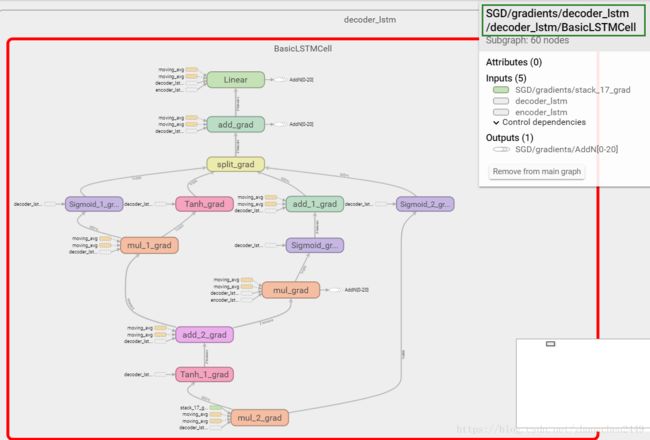基于LSTM的Chatbot实例(4) — 基于SGD的模型参数训练及优化
一、SGD基本知识
前几篇文章中已经介绍了我们的seq2seq模型使用均方误差作为损失函数,使用SGD算法(随机梯度下降)算法来训练模型参数,实例中代码如下:
net = tflearn.regression(real_output_sequence, optimizer='sgd', learning_rate=0.1, loss='mean_square') 大多数机器学习任务最后都涉及到优化算法(调整模型参数以最小化损失函数),仅使用梯度的优化算法称为一阶优化算法,如梯度下降(GD)算法。使用Hessian矩阵(二阶偏导矩阵)的优化算法称为二阶优化算法。总的来说一阶收敛算法只考虑了局部的最优,每次只从你当前所处位置选一个坡度最大的方向走一步,牛顿法在选择方向时,不仅会考虑坡度是否够大,还会考虑你走了一步之后,坡度是否会变得更大。从几何上说,牛顿法就是用一个二次曲面去拟合你当前所处位置的局部曲面,而梯度下降法是用一个平面去拟合当前的局部曲面,通常情况下,二次曲面的拟合会比平面更好,所以牛顿法选择的下降路径会更符合真实的最优下降路径,如下图所示。虽然牛顿法更快收敛到全局或局部最优解,但是迭代的每一步都需要求解目标函数的Hessian矩阵(元素数量是参数数量的平方)的逆矩阵,计算比较复杂( O(k3) O ( k 3 ) )。

因此,在机器学习中经常使用的是梯度下降优化方法,其常有以下三种迭代思路:
- 批量梯度下降(Batch gradient descent):是一种对参数的update进行累积,然后批量更新的一种方式。这种算法很慢,并且对于大的数据集并不适用;并且使用这种算法,我们无法在线更新参数。
- 随机梯度下降(Stochastic gradient descent):是一种对参数随着样本训练,一个一个的及时update的方式。这种方法迅速并且能够在线使用;但是它频繁的更新参数会使得目标函数波动很大。
- 小批量梯度下降(Mini-batch gradient descent):吸取了BGD和SGD的优点,每次选择一小部分样本进行训练
这里选用的SGD优化方法,其最基本的迭代更新算法如下(参考文献【2】):

Fig1-1 SGD 迭代算法
二、tensorflow中优化的SGD
tensorflow中使用SGD训练regression模型的关键代码如下:
# @File : tflean.layers.estimator.py
def regression(incoming, placeholder='default', optimizer='adam',
loss='categorical_crossentropy', metric='default',
learning_rate=0.001, dtype=tf.float32, batch_size=64,
shuffle_batches=True, to_one_hot=False, n_classes=None,
trainable_vars=None, restore=True, op_name=None,
validation_monitors=None, validation_batch_size=None, name=None):
""" Regression.
The regression layer is used in TFLearn to apply a regression (linear or
logistic) to the provided input. It requires to specify a TensorFlow
gradient descent optimizer 'optimizer' that will minimize the provided
loss function 'loss' (which calculate the errors). A metric can also be
provided, to evaluate the model performance."""
tr_op = TrainOp(loss=loss,
optimizer=optimizer,
metric=metric,
trainable_vars=tr_vars,
batch_size=batch_size,
shuffle=shuffle_batches,
step_tensor=step_tensor,
validation_monitors=validation_monitors,
validation_batch_size=validation_batch_size,
name=op_name)
tf.add_to_collection(tf.GraphKeys.TRAIN_OPS, tr_op)# @File : tflean.helpers.trainer.py
class TrainOp(object):
def initialize_training_ops(self, i, session, tensorboard_verbose,
clip_gradients):
""" initialize_training_ops.
Initialize all ops used for training. Because a network can have
multiple optimizers, an id 'i' is allocated to differentiate them.
This is meant to be used by `Trainer` when initializing all train ops."""
...
...
# Creating the accuracy moving average, for better visualization.
if self.metric is not None:
self.acc_averages = \
tf.train.ExponentialMovingAverage(0.9, self.training_steps,
name='moving_avg')
acc_avg_op = self.acc_averages.apply([self.metric])
else:
acc_avg_op = tf.no_op()
# Compute total loss, which is the loss of all optimizers plus the
# loss of all regularizers. Then, we summarize those losses for
# visualization in Tensorboard.
with tf.name_scope(self.name):
lss = [self.loss] + tf.get_collection(tf.GraphKeys.REGULARIZATION_LOSSES)
total_loss = tf.add_n(lss, name="Total_Loss")
loss_avg_op = summaries.add_loss_summaries(
total_loss,
self.loss,
regul_losses_collection_key=tf.GraphKeys.REGULARIZATION_LOSSES,
name_prefix=self.scope_name,
summaries_collection_key=self.name + "_training_summaries",
exp_moving_avg=0.9,
ema_num_updates=self.training_steps)
# Compute gradients operations
with tf.control_dependencies([loss_avg_op, acc_avg_op]):
self.grad = tf.gradients(total_loss, self.train_vars)
if clip_gradients > 0.0:
self.grad, self.grad_norm = \
tf.clip_by_global_norm(self.grad, clip_gradients)
self.grad = list(zip(self.grad, self.train_vars))
self.apply_grad = self.optimizer.apply_gradients(
grads_and_vars=self.grad,
global_step=self.training_steps,
name="apply_grad_op_" + str(i))
# Create other useful summary (weights, grads, activations...)
# according to 'tensorboard_verbose' level.
self.create_summaries(tensorboard_verbose)
# Track the moving averages of trainable variables
if self.ema > 0.:
var_averages = tf.train.ExponentialMovingAverage(
self.ema, self.training_steps)
var_averages_op = var_averages.apply(self.train_vars)
with tf.control_dependencies([var_averages_op]):
with tf.control_dependencies([self.apply_grad]):
self.train = tf.no_op(name="train_op_" + str(i))
else:
with tf.control_dependencies([self.apply_grad]):
self.train = tf.no_op(name="train_op_" + str(i))用tensorboard可视化出tensorflow中SGD模块的计算图如下:

Fig2-1 SGD in tensorflow
其中 绿色框1是梯度计算图。 绿色框2使用了 滑动平均来控制模型更新的速率,使模型较为平滑的更新。 绿色框3中使用 梯度剪裁来避免梯度膨胀 绿色框4是更新权重参数,同时 指数衰减调整学习率。下面将分别介绍:
#2.1 梯度计算图
梯度计算图基本上是之前使用seq2seq模型计算图的逆序(自行联想复合函数的求导过程),下面仅给出BasicLSTMCell的梯度计算图,可以和上一篇中的BasicLSTMCell计算图形成对比如下:

Fig 2-2 BasicLSTMCell gradient 计算图
 Fig 2-3 BasicLSTMCell计算图
Fig 2-3 BasicLSTMCell计算图
代码可参考截取如下:
# @File : tflean.helpers.trainer.py
class TrainOp(object):
def initialize_training_ops(self, i, session, tensorboard_verbose,
clip_gradients):
...
...
with tf.control_dependencies([loss_avg_op, acc_avg_op]):
self.grad = tf.gradients(total_loss, self.train_vars)#2.2 滑动平均
在训练神经网络时,不断保持和更新每个参数的滑动平均值,在验证和测试时,参数的值使用其滑动平均值,能有效提高神经网络的准确率。图Fig 2-1中绿色框2中对应的tensorflow源码为:
self.acc_averages = tf.train.ExponentialMovingAverage(0.9, self.training_steps, name='moving_avg')
acc_avg_op = self.acc_averages.apply([self.metric]) 其中ExponentialMovingAverage对每一个变量都会维护一个影子变量( shadow_variable s h a d o w _ v a r i a b l e ),它的初始值为对应变量的值,每次运行变量更新时,影子变量的值很更新为
其中衰减变量 decay d e c a y 随迭代步数 num_updates n u m _ u p d a t e s 更新为:
在tensorboard中计算图如下:

Fig2-4 滑动平均
#2.3 梯度剪裁
Gradient Clipping的引入是为了处理梯度爆炸(gradient explosion)和梯度消失(exploding gradient)的问题【参考On the difficulty of training Recurrent Neural Networks】。当在一次迭代中权重的更新过于迅猛的话,很容易导致loss divergence。Gradient Clipping的直观作用就是让权重的更新限制在一个合适的范围。图Fig 2-1中绿色框3中对应的tensorflow源码为:
if clip_gradients > 0.0:
self.grad, self.grad_norm = tf.clip_by_global_norm(self.grad, clip_gradients) 其clipping策略为对待更新的每个变量 t_list[i] t _ l i s t [ i ] 按如下形式更新:
其中 global_norm g l o b a l _ n o r m 计算如下:
算法源码如下:
def clip_by_global_norm(t_list, clip_norm, use_norm=None, name=None):
"""Clips values of multiple tensors by the ratio of the sum of their norms."""
if (not isinstance(t_list, collections.Sequence)
or isinstance(t_list, six.string_types)):
raise TypeError("t_list should be a sequence")
t_list = list(t_list)
if use_norm is None:
use_norm = global_norm(t_list, name)
with ops.name_scope(name, "clip_by_global_norm",
t_list + [clip_norm]) as name:
# Calculate L2-norm, clip elements by ratio of clip_norm to L2-norm
scale = clip_norm * math_ops.minimum(
1.0 / use_norm,
constant_op.constant(1.0, dtype=use_norm.dtype) / clip_norm)
values = [
ops.convert_to_tensor(
t.values if isinstance(t, ops.IndexedSlices) else t,
name="t_%d" % i)
if t is not None else t
for i, t in enumerate(t_list)]
values_clipped = []
for i, v in enumerate(values):
if v is None:
values_clipped.append(None)
else:
with ops.colocate_with(v):
values_clipped.append(
array_ops.identity(v * scale, name="%s_%d" % (name, i)))def global_norm(t_list, name=None):
"""Computes the global norm of multiple tensors. """
if (not isinstance(t_list, collections.Sequence)
or isinstance(t_list, six.string_types)):
raise TypeError("t_list should be a sequence")
t_list = list(t_list)
with ops.name_scope(name, "global_norm", t_list) as name:
values = [
ops.convert_to_tensor(
t.values if isinstance(t, ops.IndexedSlices) else t,
name="t_%d" % i)
if t is not None else t
for i, t in enumerate(t_list)]
half_squared_norms = []
for v in values:
if v is not None:
with ops.colocate_with(v):
half_squared_norms.append(gen_nn_ops.l2_loss(v))
half_squared_norm = math_ops.reduce_sum(array_ops.stack(half_squared_norms))
norm = math_ops.sqrt(
half_squared_norm *
constant_op.constant(2.0, dtype=half_squared_norm.dtype),
name="global_norm")
return norm#2.4 更新权重
在计算了梯度(2.1节) ,并对其进行滑动平均(2.2节)和梯度剪裁(2.3节)后。接下来就可以运用图Fig 1-1中的迭代公式对模型参数进行迭代。如下图所示分别对encoder_lstm和decoder_lstm中的权重(Matrix)和偏置(Bias)进行迭代更新:


代码不再赘述,这里提一下,在tflearn的SGD源码中,学习率learning_rate是指数衰减的,对应源码如下:
class SGD(Optimizer):
""" Stochastic Gradient Descent.
SGD Optimizer accepts learning rate decay. When training a model,
it is often recommended to lower the learning rate as the training
progresses. The function returns the decayed learning rate. It is
computed as:
```python
decayed_learning_rate = learning_rate *
decay_rate ^ (global_step / decay_steps)
```
"""
def build(self, step_tensor=None):
self.built = True
if self.has_decay:
if not step_tensor:
raise Exception("Learning rate decay but no step_tensor "
"provided.")
self.learning_rate = tf.train.exponential_decay(
self.learning_rate, step_tensor,
self.decay_step, self.lr_decay,
staircase=self.staircase)
tf.add_to_collection(tf.GraphKeys.LR_VARIABLES, self.learning_rate)
self.tensor = tf.train.GradientDescentOptimizer(
learning_rate=self.learning_rate,
use_locking=self.use_locking,
name=self.name)至此,基于LSTM的Chatbot实例的模型创建,训练及优化部分都介绍完毕。写一篇将模型训练过程中参数迭代情况,以及损失函数Loss变化等指标展示出来。此外还将展示已训练好的模型在测试集合上的拟合效果。
3.参考文献:
【1】Stochastic Gradient Descent Tricks
【2】Deep Learning Book
【3】Machine Learning优化算法
【4】On the difficulty of training Recurrent Neural Networks
【5】Adam: A Method for Stochastic Optimization

